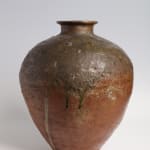-
Artworks
Tanba Storage Jar, 15th/16th century
Stoneware with natural ash glazeSize H 18¼ in. (46.4 cm)
T-4703Further images
-
(View a larger image of thumbnail 1
)

-
(View a larger image of thumbnail 2
)

-
(View a larger image of thumbnail 3
)

-
(View a larger image of thumbnail 4
)

-
(View a larger image of thumbnail 5
)

-
(View a larger image of thumbnail 6
)

-
(View a larger image of thumbnail 7
)

-
(View a larger image of thumbnail 8
)

-
(View a larger image of thumbnail 9
)

This imposing storage jar comes from Tanba, a mountainous district west of Kyoto where ash-glazed stoneware has been made for at least eight centuries. Its uneven profile is due to...This imposing storage jar comes from Tanba, a mountainous district west of Kyoto where ash-glazed stoneware has been made for at least eight centuries. Its uneven profile is due to its having been built up by hand in several stages from coils of damp clay, rather than having been thrown on a potter’s wheel. As with other ancient centers of ceramic production, such as Bizen and Shigaraki, the aesthetic effects of traditional Tanba ware—mostly appreciated by later connoisseurs rather than the original users—depended on chance kiln events that took place during firing at temperatures in excess of 2,0000F, a process that took place over several days. Ash and burning fragments of the wood used to fuel the kiln circulated and settled gradually, mainly on the shoulders, where the silica content melted and fused to create patches and streaks of glaze, one of them in this case reaching almost to the base.
Tanba ware was also one of the native Japanese everyday wares appropriated by the founding fathers of chanoyu, the Japanese Tea Ceremony, who advocated the use of these rugged vessels in combination with more finished and perfect-looking imported Chinese ceramics, then favored by the samurai elite. Tanba ware was at its peak during the late medieval period but largely fell out of fashion during later centuries until many of Japan’s historic ceramic wares were “rediscovered” some ninety years ago. After World War II, larger storage jars in particular became one of the most sought-after medieval Japanese ceramics, admired for their rugged, hand-built forms, orange-red surfaces flecked with random crystalline inclusions, and dynamic splashes of ash glaze. -
(View a larger image of thumbnail 1
)








